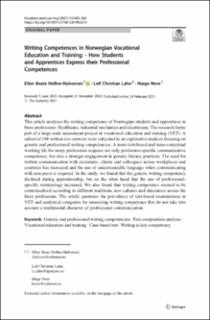| dc.contributor.author | Hellne-Halvorsen, Ellen Beate | |
| dc.contributor.author | Lahn, Leif Christian | |
| dc.contributor.author | Nore, Hæge | |
| dc.date.accessioned | 2023-01-09T16:03:48Z | |
| dc.date.available | 2023-01-09T16:03:48Z | |
| dc.date.created | 2020-02-06T14:40:01Z | |
| dc.date.issued | 2021-02-24 | |
| dc.identifier.citation | Vocations and Learning. 2021, 14 (2), 1-22. | en_US |
| dc.identifier.issn | 1874-785X | |
| dc.identifier.issn | 1874-7868 | |
| dc.identifier.uri | https://hdl.handle.net/11250/3042087 | |
| dc.description.abstract | This article analyzes the writing competences of Norwegian students and apprentices in three professions: Healthcare, industrial mechanics and electricians. The research forms part of a large-scale assessment project in vocational education and training (VET). The data stem from case-based, professionally-oriented tests, and our analysis of 108 test-solutions focuses on perspective on generic and professional writing competences. A more text-based and trans-contextual working life for many professions requires not only profession-specific communicative competency, but also a stronger engagement in generic literacy practices. The need for written communication with customers, clients and colleagues across workplaces and countries has increased and the use of understandable language when communicating with non-peers is required. In the study, we did not find such sufficient writing competences among apprentices. The generic writing competences declined during apprenticeship, but on the other hand the use of professional-specific terminology increased. We also found that the writing competences seemed to be contextualized according to different traditions, text cultures and discourses across the three professions. The article questions the prevalence of text-based examinations in VET and analytical categories for measuring writing competences that do not take into account a multimodal character of professional communication. | en_US |
| dc.language.iso | eng | en_US |
| dc.publisher | Springer | en_US |
| dc.relation.ispartofseries | Vocations and Learning;Volume 14, issue 2 | |
| dc.relation.uri | https://link.springer.com/article/10.1007/s12186-020-09262-0 | |
| dc.rights | Navngivelse 4.0 Internasjonal | * |
| dc.rights.uri | http://creativecommons.org/licenses/by/4.0/deed.no | * |
| dc.subject | Generic writing competencies | en_US |
| dc.subject | Professional writing competencies | en_US |
| dc.subject | Text composition analyses | en_US |
| dc.subject | Vocational education and training | en_US |
| dc.subject | Case-based tests | en_US |
| dc.subject | Writing as key competency | en_US |
| dc.title | Writing Competences in Norwegian Vocational Education and Training: - How Students and Apprentices Express their Professional Competences | en_US |
| dc.type | Peer reviewed | en_US |
| dc.type | Journal article | en_US |
| dc.description.version | publishedVersion | en_US |
| dc.rights.holder | © The Author(s) 2021 | en_US |
| cristin.ispublished | true | |
| cristin.fulltext | original | |
| cristin.qualitycode | 2 | |
| dc.identifier.doi | https://doi.org/10.1007/s12186-020-09262-0 | |
| dc.identifier.cristin | 1791667 | |
| dc.source.journal | Vocations and Learning | en_US |
| dc.source.volume | 14 | en_US |
| dc.source.issue | 2 | en_US |
| dc.source.pagenumber | 243–264 | en_US |
| dc.relation.project | Norges forskningsråd: 406941 | en_US |

